Posts Tagged ‘Noel Streatfeild’
March 21, 2013 @ 4:45 pm | Filed under:
Books Finally! I didn’t want to post this while so many of you were unable to load the site. So let’s talk, already!
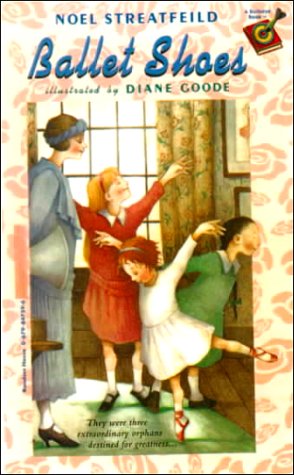
Ballet Shoes was Noel Streatfeild’s first children’s novel, published in 1937. She had already published a handful of novels for adults by this point, beginning in 1931. Before that, she worked as an actress for ten years—a somewhat unusual profession for an English vicar’s daughter at that point in time. Her experience in the world of the theater became fodder for the “Shoe” books, her most popular works and the ones for which she is best remembered nowadays.
In Ballet Shoes, we meet our first set of plucky children bound for the stage (whether they like it or not). Pauline, Petrova, and Posy Fossil aren’t sisters by birth; they are adopted by an eccentric explorer known to them as as Gum—that is, Great-Uncle Matthew. Gum collected each of them as babies, depositing them in the large house run by his great-niece, Sylvia, and her former nanny, and disappearing again. He visits infrequently and stays only long enough to drop off his latest collection of fossils or orphaned infants. All the girls really know of him are their origin stories, which loom large in their minds, and in homage to which they have chosen their distinctive surname.
Now six years have passed since anyone heard from Gum, and the money has run out. Sylvia, middle-aged and growing anxious, is worried about how to keep the house running and pay for the girls’ education. Her stopgap solution is to take on some boarders, and a luckier assortment of lodgers cannot be imagined. There’s Theo, who teaches dance at a ballet school that is to shape the Fossil girls’ future; the Simpsons, a young married couple home from India, sporting a shiny new automobile (the joy of Petrova’s life); and two retired female professors, Dr. Jakes (English literature) and Dr. Smith (mathematics), who are looking for a quiet place to devote themselves to research.
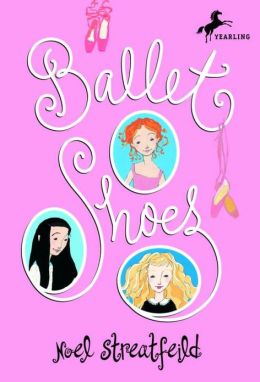 By the time the housekeeping money Gum has left runs out for good, the boarders have all fallen in love with the house and the girls, and they eagerly step in with solutions when Sylvia is at her wit’s end as to how to keep the house running. Theo convinces her to enroll all three girls in Madame Fidolia’s dance academy, where she teaches, in order to provide them a way to earn their livings when they’re older. They can begin performing for pay at age twelve, she explains, and despite initial trepidations, Sylvia agrees that the girls will be well served by having a means of income in case Gum never returns from his wandering.
By the time the housekeeping money Gum has left runs out for good, the boarders have all fallen in love with the house and the girls, and they eagerly step in with solutions when Sylvia is at her wit’s end as to how to keep the house running. Theo convinces her to enroll all three girls in Madame Fidolia’s dance academy, where she teaches, in order to provide them a way to earn their livings when they’re older. They can begin performing for pay at age twelve, she explains, and despite initial trepidations, Sylvia agrees that the girls will be well served by having a means of income in case Gum never returns from his wandering.
Her worries about their education are put to rest by the good professors, who confess to finding retirement a bit dull. And so the girls begin their tenure at the Children’s Academy of Dancing and Stage Training, studying ballet, acting, and French, and learning the ins and outs of backstage life. This is where Streatfeild’s genius lies and what sets the Shoe books apart from other novels about English orphans: she invites us into a world of dance classes and auditions, costume changes and licensing examinations, pantomimes and newspaper reviews. With brisk, beguiling strokes, she paints a picture of busy, dedicated children working hard at their craft. Even Petrova, who hates dancing, toils doggedly away, her mind on cars and airplanes but her muscles devoted to the task at hand. The “so you can earn your living” spin is fascinating (and unusual); it’s far more common in literature to see an aspiring young dancer/actor/artist/etc struggling for validation in a world populated by adults pooh-poohing the dream. Here, instead of starry-eyed dreamers, we have stalwart little workers. Even Posy, who possesses such remarkable innate ability that she commands the attention of Madame Fidolia herself, is not portrayed as a head-in-the-clouds dreamer. She approaches her training with a serious, matter-of-fact manner that amuses her elders and annoys her sisters, and when (at a very tender age) Posy deems certain classes beneath her ability and therefore not worth her time, she blows them off with that same matter-of-fact, business-as-usual manner. It’s not so much that Posy dreams of being a famous ballerina; it’s that even as a tiny child, she knows in her bones that she will be a famous ballerina and sets about working toward that inevitable future in the most practical manner.
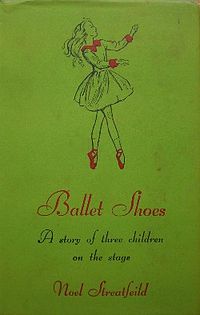 By bypassing the romantic storytelling tropes associated with the aspiring-performer plot, Streatfeild lets us experience the London stage as she must have experienced it: the schedules and commutes, the nervewracking auditions, the disappointments and triumphs, the rehearsals, the backstage bustle that is so much more central to a stage performer’s life than the brief moments of applause at the end of a show. Even as Pauline, a gifted actress (thanks in large part to Dr. Jakes’s coaching), thinks more about the tedium of a film actor’s routine than about her rave reviews and admiring fans. And I love this about Ballet Shoes: its very British prosaicness.
By bypassing the romantic storytelling tropes associated with the aspiring-performer plot, Streatfeild lets us experience the London stage as she must have experienced it: the schedules and commutes, the nervewracking auditions, the disappointments and triumphs, the rehearsals, the backstage bustle that is so much more central to a stage performer’s life than the brief moments of applause at the end of a show. Even as Pauline, a gifted actress (thanks in large part to Dr. Jakes’s coaching), thinks more about the tedium of a film actor’s routine than about her rave reviews and admiring fans. And I love this about Ballet Shoes: its very British prosaicness.
But prosaic never, in this book, equals boring—and the several threads of suspense that run through the novel keep us always in a state of pleasant anxiety. Will Pauline get the part? Will Gum return before the money runs out? Will Sylvia have to sell the house? Will Nana find a way to pay for a new and terribly necessary audition dress? Will Petrova mortify herself onstage? Will Posy—nah, there’s never any suspense about Posy. She simply won’t allow it.
The portrayal of the performing-arts world may be realistic rather than romantic, but the fates of our three heroines contain as much romance as any young reader could wish for. Pauline becomes a film star! Posy, the famous ballerina she always knew she would be. And Petrova, thanks to her mechanically minded kindred spirit, Mr. Simpson, gets to spend plenty of time tinkering with machines during her offstage hours. When she is presented with her very own pair of overalls in Mr. Simpson’s garage—and we’re told the head mechanic always saves jobs for her to do—there’s romance there a-plenty. And of course it’s Petrova the future aeronaut who will, according to her confident sisters, be the one to achieve the goal the three orphan girls have been vowing to pursue since they were tiny: to one day put the Fossil name, their own unique name, in the history books.
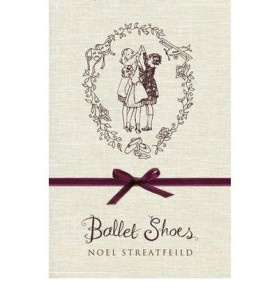 This is what I love about Streatfeild. Her books are full of unlikely coincidences (imagine the luck of that particular assortment of boarders landing on Sylvia’s doorstep) and eccentric characters, and yet she presents them in such a straightforward, everyday manner that it all seems perfectly plausible. Of course the infant Pauline survives a sunk ship and is rescued by an absentminded fossil-hunter; of course a noted Shakespearean educator winds up in charge of her education; of course she becomes a celebrated child actress. What could be more inevitable? Now what’s for tea?
This is what I love about Streatfeild. Her books are full of unlikely coincidences (imagine the luck of that particular assortment of boarders landing on Sylvia’s doorstep) and eccentric characters, and yet she presents them in such a straightforward, everyday manner that it all seems perfectly plausible. Of course the infant Pauline survives a sunk ship and is rescued by an absentminded fossil-hunter; of course a noted Shakespearean educator winds up in charge of her education; of course she becomes a celebrated child actress. What could be more inevitable? Now what’s for tea?
There’s lots more I could say, but I’ll turn the floor over to you now. I’m eager to hear your thoughts.
(Does it kill you when they sell the house and scatter? Because it kills me. Does Nana like living in Czechoslovakia, do you think?)
Next up in our Streatfeild read-along: Dancing Shoes.
March 3, 2013 @ 8:46 pm | Filed under:
Books 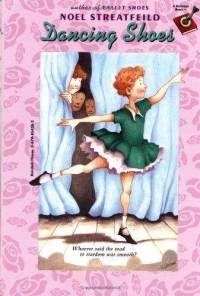 The other day I asked Jane to hunt up our copy of Noel Streatfeild’s Dancing Shoes for Beanie in relation to something we were discussing. At the time I couldn’t remember whether the event I was recalling happened in Dancing Shoes or Ballet Shoes, or possibly even Theater Shoes. It didn’t matter which, because it turned out what I was really wanting was to reread all the novels myself.
The other day I asked Jane to hunt up our copy of Noel Streatfeild’s Dancing Shoes for Beanie in relation to something we were discussing. At the time I couldn’t remember whether the event I was recalling happened in Dancing Shoes or Ballet Shoes, or possibly even Theater Shoes. It didn’t matter which, because it turned out what I was really wanting was to reread all the novels myself.
I haven’t started yet, but I’m so in the mood. Streatfeild’s writing is delicious and occupies a unique niche in children’s literature: the behind-the-scenes lives of children in the performing arts, in London, in the mid-20th century. (An extremely prolific author, she wrote a great many books about other subjects, but the only Streatfeild works I’ve read are her “Shoes” books—and not even all of those. Party Shoes, for example, is still on my TBR list.)
The cover at left is from the mid-90s reissue, which is when I was introduced to Streatfeild’s work. I missed them, somehow, growing up. During the year I spent at Random House after grad school, my boss, the brilliant Stephanie Spinner, was in charge of bringing the three Shoes books mentioned above back into print. These were the editions with the Diane Goode covers like the one pictured above.
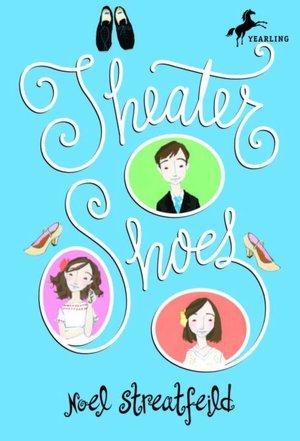 All we had to work with were out-of-print editions from the archives. I was offered the job—freelance, during my off-hours—of typing two of the manuscripts into Microsoft Word. I was either saving up for my wedding or freshly returned from my wedding (I left Random House for HarperCollins in the summer of 1994, just a few months after Scott and I got married), and the eight bucks an hour I was offered for the typing gig felt like a windfall. I remembered reading that Hunter S. Thompson honed his writing skills by typing out novels by Hemingway and Fitzgerald. There was something thrilling about continuing this practice of literary apprenticeship, and I enjoyed the hours I sat up late at night, typing onto my Mac Classic, wrapped up in these charming stories I’d never read before.
All we had to work with were out-of-print editions from the archives. I was offered the job—freelance, during my off-hours—of typing two of the manuscripts into Microsoft Word. I was either saving up for my wedding or freshly returned from my wedding (I left Random House for HarperCollins in the summer of 1994, just a few months after Scott and I got married), and the eight bucks an hour I was offered for the typing gig felt like a windfall. I remembered reading that Hunter S. Thompson honed his writing skills by typing out novels by Hemingway and Fitzgerald. There was something thrilling about continuing this practice of literary apprenticeship, and I enjoyed the hours I sat up late at night, typing onto my Mac Classic, wrapped up in these charming stories I’d never read before.
Streatfeild is a good writer to study under. Her prose is rich, wry, vivid, never treacly, laced with humor. She conjures up wonderful old London houses and populates them with memorable personalities, including adults who treat children with great respect. (Some of governesses and tutors seem straight out of Charlotte Mason’s teacher’s college at Ambleside, and I smile, sometimes, at the influence this trio of novels must have had on my ideas about education.)
Anyway, I’m in the mood for a nice Streatfeild binge and I wondered if any of you would like to join me? Which of her books is your favorite—Shoes or otherwise?
March 12, 2009 @ 10:57 am | Filed under:
Books Trying something new here…instead of straight-up book reviewing, I’m going to blog my reading notes once or twice a week. I’ve always been an unfaithful journaler of my reading because one-way dialogue (monologue I guess) isn’t terribly appealing to me. And yet, as I’m reading, there’s always so much I want to make note of, remark upon, explore, remember, question, hash out with someone else. I’m thinking the blog may lend itself nicely to that purpose. So please feel free to jump in.
Monday 3/9
—Am finding I really miss having Little Brother to turn to on the iPod. Despite its bumps (I still don’t get how it’s a YA book; some of those scenes were decidedly adult), it was entertaining and thought-provoking, and I loved reading it. Am now of course even more freaked out about privacy erosion than I was before, which is saying something. I always knew those E-Z Passes were bad news. Downloaded Doctorow’s first book, Down & Out in the Magic Kingdom, and it too is massively engaging. Sci fi future set in Disneyland. There’s no real death anymore; computer implants are so integrated into human thought that people can access internet connections from within their own heads, and they can upload backups of their memories to be downloaded into new, cloned bodies in the event of accidental demise. CREEPY.
Tuesday 3/10
—Began Lucky Girl (ARC). Certainly compelling so far. Young American woman is contacted by her Chinese birth parents, discovers she has several sisters in Taiwan. They are all eager to meet her, sending letters & faxes, calling, imploring her to come visit. Kind of a shock to her to realize they are (now at least) middle class, not the starving, miserable peasants she always imagined.
—Began new read-aloud: Red Sails to Capri. Officially to Beanie, but I noticed the other girls couldn’t help but listen in. I tried to read this to Jane years ago, didn’t get past chapter 3. The corny dialogue tanked me. But I’ve heard such raves about it as a read-aloud that I thought I’d give it a second chance. This time, knowing the bulk of the action (at least in the opening) is conveyed through dialogue, I found it more engaging. Played it up, big comical voices. Beanie’s belly laugh is totally intoxicating, I must say. She’s a delight to read to.
—And later she asked if we could return to Theater Shoes. We started it, oh, ages ago. Fell by the wayside. So I had to start over. Gosh I love Streatfeild. Nobody quite like her. (Though I suppose I do get a sort of Nesbit vibe from her tone.)
Wednesday 3/11


—Another chapter of Theater Shoes. We met Alice the housemaid today, and I was so happy to see her—I always remembered a character who talked in Cockney rhyming slang but had forgotten which book she came from. This book is set in WWII London, which has generated some good discussion with Beanie. It was eerie to see the post-bombing neighborhood through the eyes of the children in the story, the one intact wall with mantelpiece standing in the middle of the rubble.
—More Red Sails. I’m still rolling my eyes at the repetitive dialogue, plus how many times can they say each other’s names?? “Michele!” “Pietro?” “Michele! Are you there?” “Yes, Pietro, I’m here.” “Michele, I must tell you something!” and on and on it goes. And since most of the exposition is handled via dialogue, the characters are forever telling each other things the other knew perfectly well already. But: the kids (all of them, even though Jane read it long ago) are LOVING it, howling with laughter. Or maybe they’re just laughing at my French accent. I think the only way I’m going to make this book work is to do it up big. It is quite funny, and maybe the pace will pick up once we get to the actual adventure. So far it’s all set-up.


—I reread Coraline. Have been meaning to do that for weeks. I think I liked it better this time. I mean, I liked it before; it’s a gripping story well told. But this time I knew how creepy it was going to be, so I wasn’t distracted by the thoughts of “good NIGHT this is going to scare the pants off half the kids in its audience.” When Coraline (SPOILER!) goes through the mysterious door and on the other side is a flat identical to hers, and she walks into the kitchen and there’s her mother with her back turned, preparing dinner, and then she turns around and she’s got BUTTONS for eyes—!! Possibly one of the creepiest scenes I’ve ever read. (I’d expect nothing less from the guy who wrote that John Dee diner story. Egad.) “I’m your other mother.” ::::shiver::::
It’s a perfectly paced story. Interesting, though, that Neil chooses a POV that is, for the most part, a neutral observer reporting the action. We’re not (or seldom, at least) thinking Coraline’s thoughts and feeling her emotions & sensory impressions; the narrative is quite straightforward. Actually, it’s very much out of the comics tradition, now that I think about it…clear, visual storytelling, with internal monologue occuring in lean, spare captions. This contributes, I think, to the novel’s chilling effect; we’re outside observers, watching these dreadful events unfold around this very nice child. But we don’t have (I don’t at least) the same kind of deep emotional attachment to the character the way we do with a Huck or an Anne Shirley or a Betsy Ray. Or even Mary Lennox. We’re a safe distance away.
Maybe that’s why I felt such a jolt of surprise at the warmth of Coraline’s reaction to the sound of her real mother’s voice:
And then a voice that sounded like her mother’s—her own mother, her real, wonderful, maddening, infuriating, glorious mother—just said, “Well done, Coraline,” and that was enough.
We never saw Coraline being driven crazy or infuriated by her mother, never felt her irritation or affection. All their exchanges were quite matter-of-fact. So this quite passionate and touching statement hit me as incongruous, nothing at all like the emotional wallop you get from, say, Mrs. Sowerby’s first appearance in The Secret Garden—and that’s a mother the child has only ever heard about, not met.
Still, I quite like the book. Rose won’t touch it: too creepy, she says; but Jane has read it numerous times and is a huge fan.

 By the time the housekeeping money Gum has left runs out for good, the boarders have all fallen in love with the house and the girls, and they eagerly step in with solutions when Sylvia is at her wit’s end as to how to keep the house running. Theo convinces her to enroll all three girls in Madame Fidolia’s dance academy, where she teaches, in order to provide them a way to earn their livings when they’re older. They can begin performing for pay at age twelve, she explains, and despite initial trepidations, Sylvia agrees that the girls will be well served by having a means of income in case Gum never returns from his wandering.
By the time the housekeeping money Gum has left runs out for good, the boarders have all fallen in love with the house and the girls, and they eagerly step in with solutions when Sylvia is at her wit’s end as to how to keep the house running. Theo convinces her to enroll all three girls in Madame Fidolia’s dance academy, where she teaches, in order to provide them a way to earn their livings when they’re older. They can begin performing for pay at age twelve, she explains, and despite initial trepidations, Sylvia agrees that the girls will be well served by having a means of income in case Gum never returns from his wandering. By bypassing the romantic storytelling tropes associated with the aspiring-performer plot, Streatfeild lets us experience the London stage as she must have experienced it: the schedules and commutes, the nervewracking auditions, the disappointments and triumphs, the rehearsals, the backstage bustle that is so much more central to a stage performer’s life than the brief moments of applause at the end of a show. Even as Pauline, a gifted actress (thanks in large part to Dr. Jakes’s coaching), thinks more about the tedium of a film actor’s routine than about her rave reviews and admiring fans. And I love this about Ballet Shoes: its very British prosaicness.
By bypassing the romantic storytelling tropes associated with the aspiring-performer plot, Streatfeild lets us experience the London stage as she must have experienced it: the schedules and commutes, the nervewracking auditions, the disappointments and triumphs, the rehearsals, the backstage bustle that is so much more central to a stage performer’s life than the brief moments of applause at the end of a show. Even as Pauline, a gifted actress (thanks in large part to Dr. Jakes’s coaching), thinks more about the tedium of a film actor’s routine than about her rave reviews and admiring fans. And I love this about Ballet Shoes: its very British prosaicness. This is what I love about Streatfeild. Her books are full of unlikely coincidences (imagine the luck of that particular assortment of boarders landing on Sylvia’s doorstep) and eccentric characters, and yet she presents them in such a straightforward, everyday manner that it all seems perfectly plausible. Of course the infant Pauline survives a sunk ship and is rescued by an absentminded fossil-hunter; of course a noted Shakespearean educator winds up in charge of her education; of course she becomes a celebrated child actress. What could be more inevitable? Now what’s for tea?
This is what I love about Streatfeild. Her books are full of unlikely coincidences (imagine the luck of that particular assortment of boarders landing on Sylvia’s doorstep) and eccentric characters, and yet she presents them in such a straightforward, everyday manner that it all seems perfectly plausible. Of course the infant Pauline survives a sunk ship and is rescued by an absentminded fossil-hunter; of course a noted Shakespearean educator winds up in charge of her education; of course she becomes a celebrated child actress. What could be more inevitable? Now what’s for tea?
 The other day I asked Jane to hunt up our copy of Noel Streatfeild’s
The other day I asked Jane to hunt up our copy of Noel Streatfeild’s  All we had to work with were out-of-print editions from the archives. I was offered the job—freelance, during my off-hours—of typing two of the manuscripts into Microsoft Word. I was either saving up for my wedding or freshly returned from my wedding (I left Random House for HarperCollins in the summer of 1994, just a few months after Scott and I got married), and the eight bucks an hour I was offered for the typing gig felt like a windfall. I remembered reading that Hunter S. Thompson honed his writing skills by typing out novels by Hemingway and Fitzgerald. There was something thrilling about continuing this practice of literary apprenticeship, and I enjoyed the hours I sat up late at night, typing onto my Mac Classic, wrapped up in these charming stories I’d never read before.
All we had to work with were out-of-print editions from the archives. I was offered the job—freelance, during my off-hours—of typing two of the manuscripts into Microsoft Word. I was either saving up for my wedding or freshly returned from my wedding (I left Random House for HarperCollins in the summer of 1994, just a few months after Scott and I got married), and the eight bucks an hour I was offered for the typing gig felt like a windfall. I remembered reading that Hunter S. Thompson honed his writing skills by typing out novels by Hemingway and Fitzgerald. There was something thrilling about continuing this practice of literary apprenticeship, and I enjoyed the hours I sat up late at night, typing onto my Mac Classic, wrapped up in these charming stories I’d never read before.
